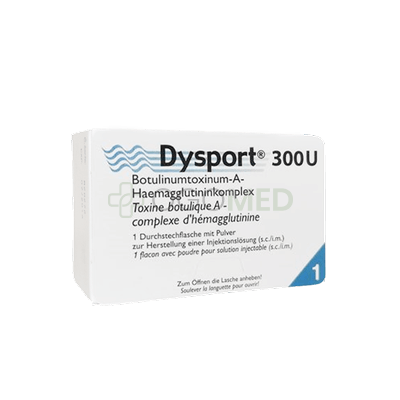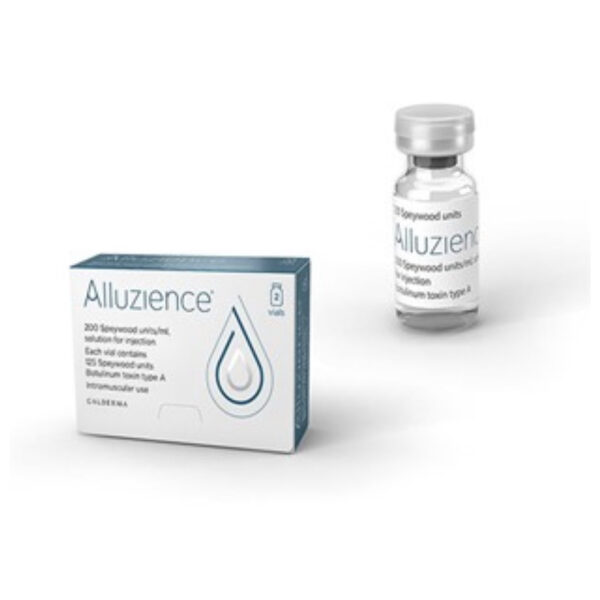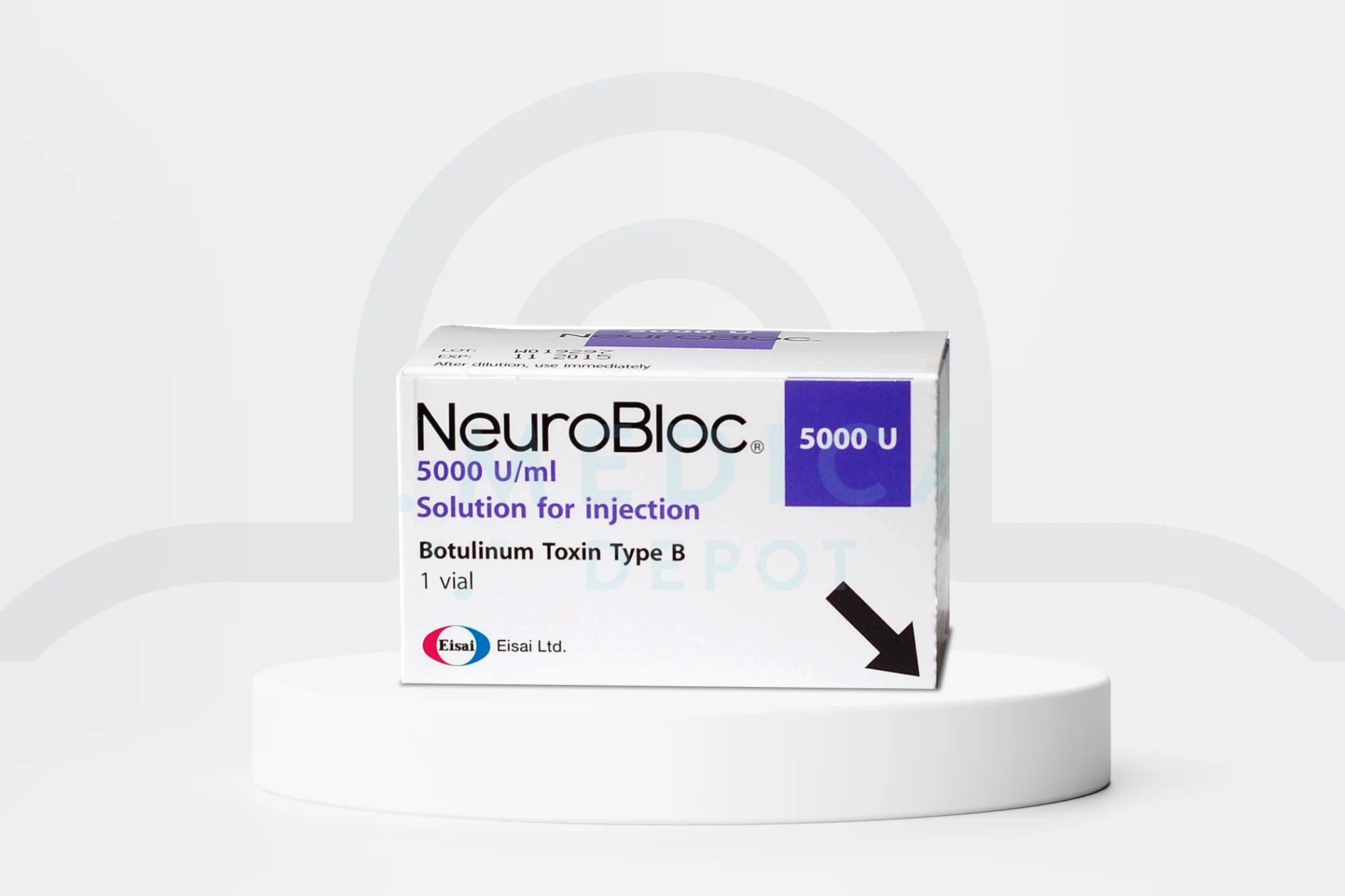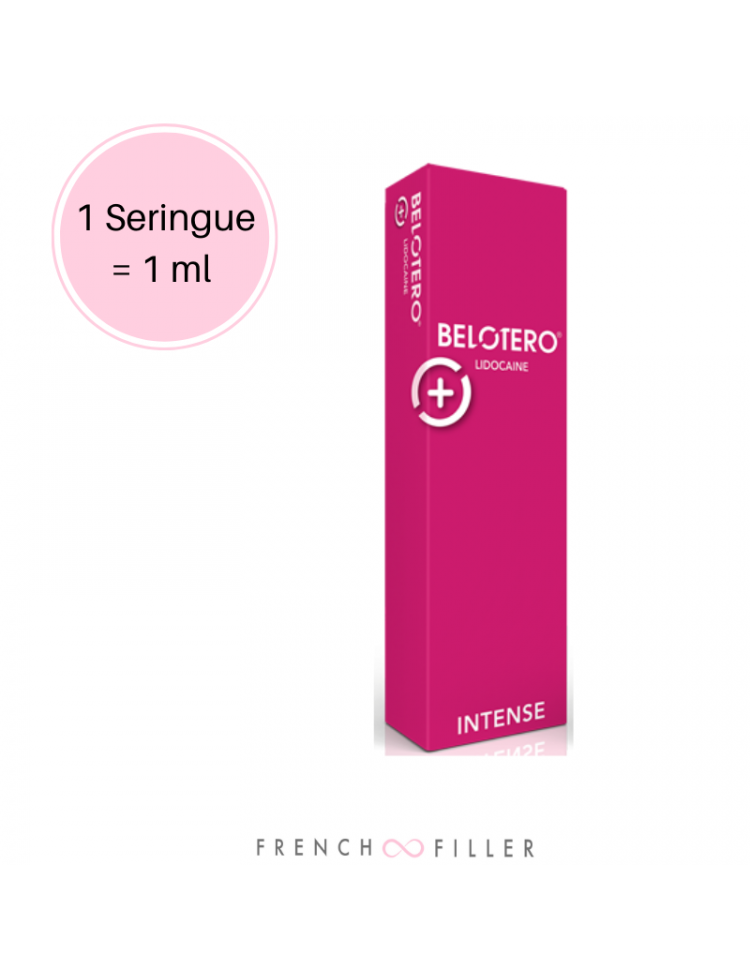Fast delivery within 72 Hours
NeuroBloc 5000u/ml 1 Vial
€80
NeuroBloc injectable works by decreasing or blocking muscle contractions. It contains the active ingredient “Botulinum Toxin Type B.”
NeuroBloc is used to treat a condition called cervical dystonia (torticollis). This refers to muscle contractions in the neck and/or shoulders that you suffer from and cannot control.
Black Friday Blowout!
Description
| The MPA patents database covers the patent expiry of all medicinal, pharmaceutical products with a marketing authorisation in the EU. It includes supplementary protection certificates SPCs, paediatric extensions, EU first marketing authorisation and more. In order to obtain access to the database or for a product demonstration, please contact us. |
NeuroBloc 5000 U/ml solution for injection.
Each ml contains 5000 U Botulinum Toxin Type B.
Each 0.5 ml vial contains 2500 U Botulinum Toxin Type B.
Each 1.0 ml vial contains 5000 U Botulinum Toxin Type B.
Each 2.0 ml vial contains 10,000 U Botulinum Toxin Type B.
Produced in Clostridium botulinum Serotype B (Bean Strain) cells.
For the full list of excipients, see section 6.1.
Solution for injection.
Clear and colourless to light yellow solution.
NeuroBloc is indicated for the treatment of cervical dystonia (torticollis) in adults.
NeuroBloc should only be administered by a physician who is familiar with and experience in the treatment of cervical dystonia and in the use of botulinum toxins.
Restricted to hospital use only.
Posology
The initial dose is 10,000 U and should be divided between the two to four most affected muscles. Data from clinical studies suggest that efficacy is dose dependent, but these trials, because they were not powered for a comparison, do not show a significant difference between 5000 U and 10,000 U. Therefore an initial dose of 5000 U may also be considered, but a dose of 10,000 U may increase the likelihood of clinical benefit.
Injections should be repeated as required to maintain good function and minimise pain. In long term clinical studies, the average dosing frequency was approximately every 12 weeks, however this may vary between subjects and a proportion of patients maintained a significant improvement relative to baseline for 16 weeks or longer. The dosing frequency should therefore be adapted based on the clinical assessment /response of an individual patient.
For patients with reduced muscle mass the dose should be adjusted according to individual patient need.
The potency of this medicinal product is expressed in NeuroBloc 5000 U/ml. These units are not interchangeable with the units used to express the potency of other botulinum toxin preparations (see section 4.4).
Older people
No dose adjustment is required in older people ≥ 65 years of age.
Renal and hepatic impairment
Studies have not been carried out in patients with hepatic or renal impairment. However, the pharmacological characteristics do not indicate any need to adjust the dose.
Paediatric population
The safety and efficacy of NeuroBloc in children aged 0-18 years have not yet been established. No data are available. NeuroBloc is not recommended in children aged 0-18 years until further data become available.
Method of administration
NeuroBloc must only be administered by intramuscular injection. Particular caution should be paid to ensure that it is not injected into a blood vessel.
The initial dose of 10,000 U should be divided between the two to four most affected muscles.
To allow division of the total dose between several injections, NeuroBloc may be diluted with sodium chloride 9 mg/ml (0.9%) solution for injection and the solution used immediately. For instructions on dilution of the product before administration, see section 6.6.
Hypersensitivity to the active substance or to any of the excipients listed in section 6.1.
Individuals with known neuromuscular diseases (e.g. amyotrophic lateral sclerosis or peripheral neuropathy) or known neuromuscular junctional disorders (e.g. myasthenia gravis or Lambert-Eaton syndrome) must not be given NeuroBloc.
NeuroBloc is recommended for intramuscular administration only.
The safety of NeuroBloc outside the approved indication has not been established. This warning includes use in children and in any other indication besides cervical dystonia. The risks, which can include death, may outweigh the potential benefits.
Seroconversion
As with many biological/biotechnology proteins used as therapeutic agents, repeated administration of NeuroBloc may be associated with development of antibodies to Botulinum Toxin Type B in some patients. Immunogenicity data from three long term clinical studies indicate that approximately one third of patients develop antibodies, as determined by the mouse neutralisation / mouse protection assay dependent on duration of exposure (see section 5.1).
An investigation into the consequence of seroconversion showed that the presence of antibodies was not synonymous with a loss of clinical response, and did not have an impact on the overall safety profile. However, the clinical relevance of the presence of antibodies as determined by the mouse neutralisation / mouse protection assay is uncertain.
Caution should be used in patients with bleeding disorders or receiving anticoagulant therapy.
Spread of toxin effect
Neuromuscular effects related to spread of toxin, distant from the site of administration have been reported (see section 4.8). These include dysphagia and breathing difficulties.
Pre-Existing neuromuscular disorders
Patients treated with therapeutic doses may experience exaggerated muscle weakness. Patients with neuromuscular disorders may be at increased risk of clinically significant effects including severe dysphagia and respiratory compromise from typical doses of NeuroBloc (see section 4.3).
There have been spontaneous reports of dysphagia, aspiration pneumonia and/or potentially fatal respiratory disease, after treatment with Botulinum Toxin Type A/B.
Children (non approved use) and patients with underlying neuromuscular disorders including swallowing disorders are at increased risk of these adverse reactions. In patients with neuromuscular disorders or history of dysphagia and aspiration, botulinum toxins should only be used in an experimental setting under strict medical supervision.
Following NeuroBloc treatment, all patients and caregivers should be advised to seek medical attention for respiratory difficulties, choking or any new or worsening dysphagia.
Dysphagia has been reported following injection to sites other than the cervical musculature.
Lack of interchangeability between botulinum toxin products
The initial starting dose of 10,000 U (or 5000 U) is relevant only to NeuroBloc (Botulinum Toxin Type B). These dose units are specific to NeuroBloc only and are not relevant to preparations of Botulinum Toxin Type A. The unit dose recommendations for Botulinum Toxin Type A are significantly lower than those for NeuroBloc and administration of Botulinum Toxin Type A at the unit dose recommended for NeuroBloc may result in systemic toxicity and life-threatening clinical sequelae.
The effect of administering different botulinum neurotoxin serotypes concurrently is unknown. However, in clinical studies, NeuroBloc was administered 16 weeks after the injection of Botulinum Toxin Type A.
Co-administration of NeuroBloc and aminoglycosides or agents interfering with neuromuscular transmission (e.g. curare-like compounds) should be considered with caution.
Pregnancy
Animal reproduction studies are insufficient with respect to effects on pregnancy and embryonal/foetal development. The potential risk for humans is unknown. NeuroBloc should not be used during pregnancy unless the clinical condition of the woman requires treatment with Botulinum Toxin Type B.
Breast-feeding
It is unknown whether Botulinum Toxin Type B is excreted in human breast milk. The excretion of Botulinum Toxin Type B in milk has not been studied in animals. A decision must be made on whether to continue/discontinue breast-feeding or to continue/discontinue therapy with NeuroBloc taking into account the benefit of breast-feeding to the child and the benefit of NeuroBloc therapy to the woman.
Fertility
No fertility studies have been performed and it is not known whether NeuroBloc can affect reproduction capacity.
No studies on the effects on the ability to drive and use machines have been performed. Neurobloc may impair the ability to drive or operate machinery in case of adverse reactions such as muscle weakness and eye disorders (blurred vision, eyelid ptosis).
The most commonly reported adverse reactions associated with NeuroBloc treatment were dry mouth, dysphagia, dyspepsia, and injection site pain.
Adverse reactions related to spread of toxin distant from the site of administration have been reported: exaggerated muscle weakness, dysphagia, dyspnoea, aspiration pneumonia with fatal outcome in some cases (see section 4.4).
Adverse reactions seen in all clinical studies are listed below according to MedDRA system organ class and in decreasing frequency which is defined as follows: Very Common (>1/10); Common (>1/100 to <1/10); Uncommon (>1/1000 to <1/100).
| System Organ Class | Very Common | Common |
| Nervous system disorders | dry mouth, headache | torticollis (worsening from baseline), taste perversion |
| Eye disorders | blurred vision | |
| Respiratory thoracic and mediastinal disorders | dysphonia | |
| Gastrointestinal disorders | dysphagia | dyspepsia |
| Musculoskeletal connective tissue and bone disorders | myasthenia | |
| General disorders and administration site conditions | injection site pain
|
neck pain
influenza like illness |
In common with Botulinum Toxin Type A, electrophysiological jitter, which is not associated with clinical weakness or other electrophysiological abnormalities, may be experienced in some distant muscles.
Post marketing experience
Side effects related to spread of toxin distant from the site of administration have been reported (exaggerated muscle weakness, dysphagia, dyspnoea, aspiration pneumonia with fatal outcome in some cases) (see section 4.4).
The following effects have also been reported during post marketing use: abnormal accommodation, ptosis, vomiting, constipation, flu-like symptoms, asthenia, angioedema, rash, urticaria and pruritus.
The available reports indicate that the product has been used in the paediatric population. Case reports are more likely to be serious in children (40%) compared to those in adults and older people (12%), possibly as a result of using an inappropriately high dosage for the child. (see section 4.9)
Reporting of suspected adverse reactions
Reporting suspected adverse reactions after authorisation of the medicinal product is important. It allows continued monitoring of the benefit/risk balance of the medicinal product. Healthcare professionals are asked to report any suspected adverse reactions via the Yellow Card Scheme Website: www.mhra.gov.uk/yellowcard
Cases of overdose (some with signs of systemic toxicity) have been reported. In the event of an overdose, general medical supportive measures should be instituted. Doses of up to 15,000 U have infrequently resulted in clinically significant systemic toxicity in adults. If botulism is clinically suspected, hospitalisation for the monitoring of respiratory function (incipient respiratory failure) may be required.
In the event of an overdose or injection into a muscle that normally compensates for the cervical dystonia, it is conceivable that the dystonia may worsen. As with other botulinum toxins spontaneous recovery will occur over a period of time.
Pediatric use (non approved): in children, clinically significant systemic toxicity has occurred at doses approved for the treatment of adult patients. The risk of spreading of effect is greater than in adults, and more frequently severe. This can be due to the high dosages usually used in this population.
Pharmacotherapeutic group:
Muscle relaxant, peripherally acting agents, ATC code: M03AX 01
NeuroBloc is a neuromuscular blocking agent. The mechanism of action of NeuroBloc in blocking neuromuscular conduction occurs by a three-step process:
1. Extracellular binding of the toxin to specific acceptors on motor nerve terminals
2. Internalisation and release of the toxin into the cytosol of the nerve terminals
3. Inhibition of acetylcholine release from nerve terminals at the neuromuscular junction
When injected directly into a muscle, NeuroBloc causes a localised paralysis that gradually reverses over time. The mechanism by which muscle paralysis is reversed over time remains unknown, but may be associated with the intraneuronal turnover of the affected protein and/or sprouting of the nerve ending.
A series of clinical studies have been conducted to evaluate the efficacy and safety of NeuroBloc in the treatment of cervical dystonia. These studies have demonstrated the activity of NeuroBloc in both treatment-naïve patients, and patients who have previously received treatment with Botulinum Toxin Type A, including those that were considered clinically resistant to Botulinum Toxin Type A.
Two Phase III randomised, multicentre, double-blind, placebo-controlled studies were conducted in patients with cervical dystonia. Both studies enrolled adult patients (≥ 18 years) who had a history of receiving Botulinum Toxin Type A. The first study enrolled patients who were clinically resistant to type A toxin (A-non responders), confirmed by a Frontalis Type A test. The second study enrolled patients who continued to respond to type A toxin (A-responders). In the first study, type A resistant patients (A-non responders) were randomised to receive placebo or 10,000 U of NeuroBloc and in the second, type A toxin responsive patients (A-responders) were randomised to receive placebo, 5000 U or 10,000 U of toxin. The medicinal product was injected on a single occasion into 2 to 4 of the following muscles: splenius capitus, sternocleidomastoid, levator scapulae, trapezius, semispinalis capitus and scalene. The total dose was divided between the selected muscles and 1 to 5 injections per muscle were administered. There were 77 subjects enrolled into the first study and 109 into the second. Patient evaluations continued for 16 weeks post injection.
The primary efficacy outcome variable for both studies was the Toronto Western Spasmodic Torticollis Rating Scale (TWSTRS)-Total score (range of possible scores is 0-87) at Week 4. The secondary endpoints included Visual Analogue Scales (VAS) to quantify the Patient Global Assessment of change and the Physician Global Assessment of change, both from baseline to Week 4. On these scales, scores of 50 indicate no change, 0 much worse, and 100 much better. Results of comparisons of the primary and secondary efficacy variables are summarised in Table 1. Analysis of the TWSTRS sub scales revealed significant effects on the severity of cervical dystonia and its associated pain and disability.
| Table 1:
Efficacy Results from Phase III NeuroBloc Studies
|
|||||
| STUDY 1
(A-Resistant Patients)
|
STUDY 2
(A-Responsive Patients)
|
||||
| Assessments | Placebo | 10,000 U | Placebo | 5000 U | 10,000 U |
| n = 38 | n = 39 | n = 36 | n = 36 | n = 37 | |
| TWSTRS-Total | |||||
| Mean At Baseline | 51.2 | 52.8 | 43.6 | 46.4 | 46.9 |
| Mean at Week 4 | 49.2 | 41.8 | 39.3 | 37.1 | 35.2 |
| Change from Baseline | -2.0 | -11.1 | -4.3 | -9.3 | -11.7 |
| P-Value* | 0.0001 | 0.0115 | 0.0004 | ||
| Patient Global | |||||
| Mean at Week 4 | 39.5 | 60.2 | 43.6 | 60.6 | 64.6 |
| P-Value* | 0.0001 | 0.0010 | 0.0001 | ||
| Physician Global | |||||
| Mean at Week 4 | 47.9 | 60.6 | 52.0 | 65.3 | 64.2 |
| P-Value* | 0.0001 | 0.0011 | 0.0038 | ||
* Analysis of covariance, two-tailed tests, α = 0.05
A further randomised, multicentre, double-blind study was conducted to compare the efficacy of NeuroBloc (10,000 U) to Botulinum Toxin Type A (150 U) in patients with cervical dystonia who have never previously received a botulinum toxin product. The primary efficacy assessment was the TWSTRS Total score, and secondary efficacy assessments included VAS assessment of change evaluated by patient and investigator, conducted at 4, 8 and 12 weeks after treatment. The study met the pre-defined criteria for non-inferiority of NeuroBloc compared to Botulinum Toxin Type A, both in terms of mean TWSTRS total score at week 4 after first and second treatment sessions, and in terms of duration of effect.
The non-inferiority of NeuroBloc compared to Botulinum Toxin Type A was further supported by a responder analysis where similar percentages of subjects showed improvement in the TWSTRS score at Week 4 of Session 1 (86% NeuroBloc and 85% Botox), and a similar proportion of subjects experienced at least a 20% decrease from baseline in the TWSTRS score at Week 4 of Session 1 (51% NeuroBloc, 47% Botox).
Further clinical studies and open label follow-up have shown that subjects can continue to respond to NeuroBloc for prolonged periods of time, with some subjects receiving more than 14 treatment sessions over a period of more than 3.5 years. In addition to improved function as demonstrated by a reduction in TWSTRS-total score, treatment with NeuroBloc was associated with a significant reduction in TWSTRS-Pain and pain VAS scores at each treatment session at weeks 4, 8 and 12 relative to baseline. In these studies, the average dosing frequency was approximately every 12 weeks.
The immunogenicity of NeuroBloc has been evaluated in two clinical studies and an open-label extension study. The presence of antibodies in these studies was assessed using the mouse protection assay (also known as the Mouse Neutralization Assay, MNA).
Immunogenicity data from three long-term clinical studies indicate that approximately one third of patients develop antibodies, as determined by the mouse neutralisation / mouse protection assay dependent on duration of exposure. Specifically, these studies showed approximately 19-25% seroconverted within 18 months of initiation of treatment, increasing to approximately 33-44% with up to 45 months of treatment. An investigation into the consequence of seroconversion showed that the presence of antibodies was not synonymous with a loss of clinical response, and did not have an impact on the overall safety profile. However, the clinical relevance of the presence of antibodies as determined by the mouse neutralisation / mouse protection assay is uncertain.
The extent and time course of seroconversion were similar in patients with prior toxin A exposure and those who were toxin A naïve, and between toxin A resistant and toxin A responsive patients.
NeuroBloc injected intramuscularly produces localised muscle weakness by chemical denervation. Following local intramuscular injection of NeuroBloc serious adverse events that may have been due to systemic effects of Botulinum Toxin Type B, were observed in 12% of adverse reaction cases reported during the post-marketing experience (including the following adverse reactions: dry mouth, dysphagia and blurred vision). However, no pharmacokinetic or Absorption, Distribution, Metabolism and Excretion (ADME) studies have been performed.
Single dose pharmacology studies in cynomolgus monkeys have shown no effects other than the anticipated dose-dependent paralysis of injected muscles, together with some diffusion of toxin at high doses producing similar effects in neighbouring non-injected muscles.
Single dose intramuscular toxicology studies have been performed in cynomolgus monkeys. The systemic No Observed Effect Level (NOEL) was shown to be approximately 960 U/kg. The dose resulting in death was 2400 U/kg.
Because of the nature of the product, no animal studies have been carried out to establish the carcinogenic effects of NeuroBloc. Standard tests to investigate the mutagenicity of NeuroBloc have not been performed.
Development studies in rats and rabbits have shown no evidence of foetal malformations or changes to fertility. In the development studies, the No Observed Adverse Effect Dose Level (NOAEL) in rats was 1000 U/kg/day for maternal effects and 3000 U/kg/day for foetal effects. In rabbits, the NOAEL was 0.1 U/kg/day for maternal effects and 0.3 U/kg/day for foetal effects. In the fertility studies the NOAEL was 300 U/kg/day for general toxicity in both males and females and 1000 U/kg/day for fertility and reproductive performance.
Disodium succinate
Sodium chloride
Human serum albumin
Hydrochloric acid (for pH adjustment)
Water for injections
In the absence of compatibility studies, this medicinal product must not be mixed with other medicinal products.
3 years, as packaged for sale.
Use immediately if diluted (see section 4.2 and section 6.6).
From a microbiological point of view, unless the method of opening/dilution precludes the risk of microbial contamination the product should be used immediately.
Store in a refrigerator at 2°C-8°C.
Do not freeze.
Keep the container in the outer carton in order to protect from light.
Within its shelf-life, the product may be removed from the refrigerator for a single period of up to 3 months at a temperature not above 25°C, without being refrigerated again. At the end of this period, the product should not be put back in the refrigerator and should be disposed of.
For storage conditions after dilution of the medicinal product, see section 6.3.
0.5 ml, 1 ml or 2 ml solution in a 3.5 ml Type I glass vial, with siliconised butyl rubber stoppers oversealed by aluminium crimped caps.
Pack size of 1.
NeuroBloc is provided in vials for single use only.
The medicinal product is ready to use and no reconstitution is required. Do not shake.
To allow division of the total dose between several injections, NeuroBloc may be diluted with sodium chloride 9 mg/ml (0.9%) solution for injection (see section 4.2). Such dilutions with sodium chloride should be done in a syringe, pulling out the desired amount of Neurobloc into the syringe first, and then adding sodium chloride to the syringe. In non clinical experiments, NeuroBloc solution has been diluted up to 6-fold without any resulting change in potency. Once diluted, the medicinal product must be used immediately as the formulation does not contain a preservative.
Any unused solution, all vials of expired NeuroBloc and equipment used in the administration of the medicinal product should be carefully discarded as Medical Bioharzardous Waste in accordance with local requirements. Vials should be visually inspected prior to use. If the NeuroBloc solution is not clear and colourless/light yellow or if the vial appears damaged, the product should not be used, but discarded as Medical Biohazardous Waste in accordance with local requirements.
Decontaminate any spill with 10% caustic solution, or sodium hypochlorite (household chlorine bleach –2 ml (0.5%): 1 litre water) solution. Wear waterproof gloves and soak up the liquid with an appropriate absorbent. Place the absorbed toxin in an autoclave bag, seal it and process as Medical Biohazardous Waste in accordance with local requirements.
Eisai Limited
European Knowledge Centre
Mosquito Way
Hatfield
Hertfordshire
AL10 9SN
United Kingdom
EU/1/00/166/001 – 2500 U
EU/1/00/166/002 – 5000 U
EU/1/00/166/003 – 10,000 U
NeuroBloc injectable works by decreasing or blocking muscle contractions. It contains the active ingredient “Botulinum Toxin Type B.”
NeuroBloc is used to treat a condition called cervical dystonia (torticollis). This refers to muscle contractions in the neck and/or shoulders that you suffer from and cannot control.
Proposed by the Public Drug Database (BDPM)
Active ingredient: botulinum (toxin) type b
List of other ingredients: Disodium succinate
Sodium chloride
Human serum albumin
- Other
- What dose will you be given?
- How NeuroBloc will be administered to you
- Receiving further NeuroBloc injections
- If you received more NeuroBloc than you should
NeuroBloc will be administered to you by a physician with specialist experience in the treatment of cervical dystonia and the use of botulinum toxins.
-Your doctor may divide the dose to be injected into different muscle areas.
If you feel the effect of NeuroBloc is too strong or too weak, talk to your doctor.
-If you have difficulty breathing or are worried about symptoms that are not related to the injected muscles
, talk to your doctor immediately. If they are unavailable, contact an emergency department. You may need emergency treatment.
A serious condition called “botulism,” which causes muscle paralysis and respiratory failure, could occur if too high a dose of the active substance (botulinum toxin) is given.
This is no longer allowed when injected into the body. If your doctor suspects botulism, you will be admitted to the hospital and your breathing (respiratory function) will be monitored. Patients usually recover after a while.










